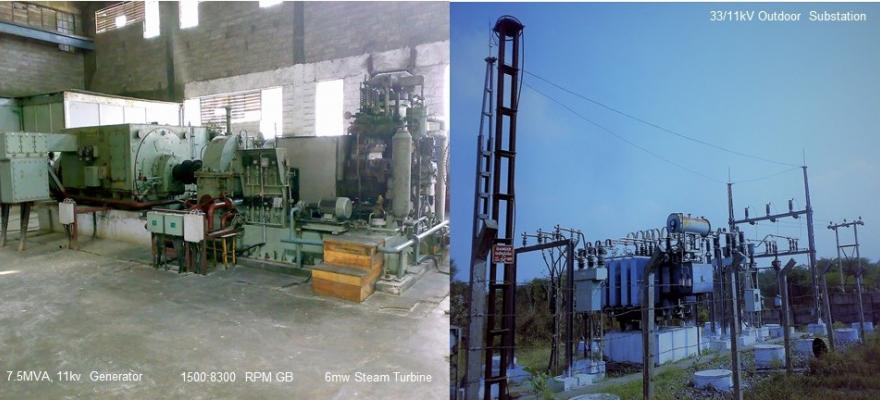
Protection Relay
Cogeneration power plants are increasingly facing operation disruption. Its protection relay trips on grid's electrical fault or with voltage fluctuation. A 6MW, 11kV steam power plant had reported frequent nuisance tripping with its protection relay system. The problem appeared after it had replaced the legacy steam powered mill drive with DC thyristor drive in sugar mills and variable frequency IGBT drives (VFD drive) in process and boiler auxiliary loads in 2010. This was done to achieve higher energy efficiency. It is a cogeneration power plant of a 4500TCD sugar cane milling unit which after supplying power to sugar process load, exports the excess power to grid through a 6.3MVA, 11/33kv, 50Hz step up grid transformer. Its prime mover, turbine is powered by steam generated from an agro fuel (bagasse) fired boiler of 40TPH, 42kg/cm2, 430oC specification. The exhaust steam from turbine is taken out in two stages for sugar process requirement. The 1st exhaust is at 2.5kg/cm2 for process and final exhaust is at 0.1kg/cm2 for re-circulation to the boiler after condensing it into water in a condenser. It's an extraction cum condensing type cogeneration power plant. Its energy efficiency, in terms of specific steam consumption (SEGR) is 5.2Ton/ MW. The power plant was commissioned in 1995. It operates in a delicate mode of steam and power balancing. Nuisance tripping in protection relay beaks that balance, and compels the steam safety valve in the boiler to actuate, and vents out tons of high pressure steam.
Harmonic distortion in the plant's electrical power system was found to be the root cause of the problem. Excessive current harmonic was coming from the sugar mills and power plant's auxiliary VSD (variable speed drive) loads. That in turn created significant voltage harmonic distortion in the electrical power system. When the protection relays activate and isolate the 33kv grid incomer circuit breaker on an electrical fault in the grid or on account of uncontrolled grid disturbance like voltage and power surge; the power plant should come back to island mode of operation and continue to supply power to home load. That's normal protection relay operation designed to isolate only the defective part of the power system. But problem occurred wherein the protection relay, in-addition tripped the station generator's 11kV circuit breaker. That used to cause a complete blackout, and restarting the power plant from a cold start used to be a daunting task. The nuisance tripping was reported with the following protection relays.
1. The 11kV Generator circuit breaker trips on Earth Fault Relay but after thorough check and megger, no earth fault emerges, and on reset the relay works normally.
2. The 11kV Generator circuit breaker trips on Generator Differential Protection Relay but after thorough check and megger, no generator internal ground/earth fault emerges, and on reset the relay works OK.
3. The boiler operation is controlled through a SCADA (DCS) system. In the event of a voltage fluctuation or voltage sag in the grid, at times, causes some control loop in the SCADA's control and instrumentation system to become unresponsive, and hangs which trips the power plant and causes a blackout.
4. The variable frequency drive (VFD) in the power plant's auxiliary load, at times, trips due to voltage fluctuations or voltage sags in the grid. It breaks the delicate steam and power balance; whose extent depends upon the criticality of the tripped VFD drive.
5. If the 33kV Grid incomer circuit breaker trips on Over Voltage Relay, the turbine generator (TG) is unable to hold-on in Island mode with its home load, and trips the 11kV generator circuit breaker on voltage relay. The issue was analyzed and found not to be a harmonic distortion related problem. It was recommended to solve with appropriate AVR Preposition Setting for operation in Island mode.
6. In the event of a grid outage due to an earth fault in the upstream grid feeder or substation; the 11kV generator circuit breaker trips on frequency relay as the governor is unable to hold on to its home load in island mode of operation. The issue was analyzed and found not to be a harmonic distortion related problem. It was recommended be solve with appropriate Governor Preposition Setting for Island mode of operation. The F4-Key of the Woodward make Governor may not have been set appropriately on preposition for the island mode of operation.
7. On a rainy day and in particular with a lightning and thunderstorm days, domestic type earth leakage relays (ELCB) for single phase lighting and small utility loads, trip both in the factory and in colony areas. The ELCBs after reset work fine.
A detailed power system measurement and power quality harmonic analysis was carried out during the year 2011- 2012. Series harmonic resonance was observed that used to cause momentary power surge and voltage sag. The bad power quality arise because of an electrical power system's interaction with the power surge in the grid and the harmonic distortion within the power plant. Whereas the power surges in a grid are dynamic and unpredictable; the harmonic distortions within a power plant are controllable. Whenever an electrical power system is susceptible at a point the possibility of a power harmonic resonance and the resultant power quality tripping and failure is high. Harmonic solution was provided and passive tuned harmonic filters were installed in 2012. It mitigated the reported nuisance tripping issues with the protection relay system.
Protection Relay in a Power Plant: The methodology of harmonic solution and the pros and cons of the installed passive tuned harmonic filter is deliberated under case study section. In the succeeding web pages, we shall examine the design and the elements of protection relay in a power plant with grid synchronization. It may be noted that this power plant was installed during 1990's wherein electro-mechanical relays were in vogue as against today's Digital, also called Numeric or Microprocessor relays. The digital relay with its black box configuration has exceptionally altered the physical structure of the relay panel. But its functionality has remained the same as that of the electro-mechanical relay. Our minds comprehend a picture faster and electro-mechanical relays with its physical existence for each ANSI device number and type are, better engineering resources for the conceptualization and design of a protection relay system in a power plant.


















